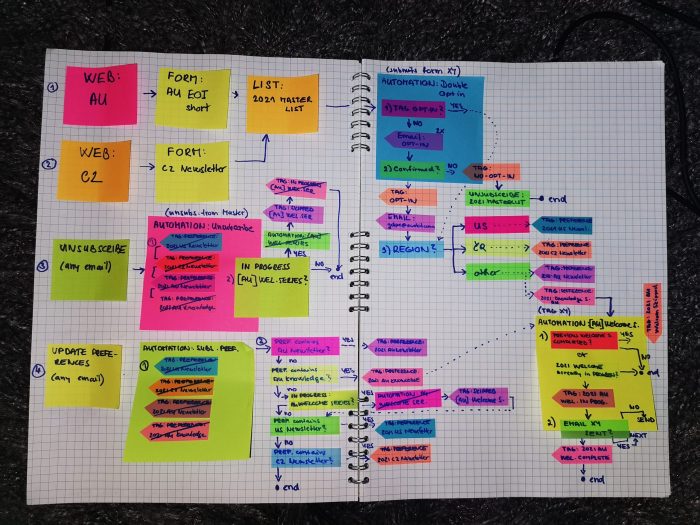How to organize a project effectively is crucial for success in any undertaking. This guide delves into the entire project lifecycle, from defining scope and planning to execution, monitoring, and closure. We’ll explore various methodologies, tools, and strategies to ensure your projects are well-structured, efficiently managed, and ultimately successful.
From outlining clear goals and deliverables to effectively managing resources and communication, this comprehensive approach will equip you with the knowledge and skills to navigate any project with confidence. Learn how to avoid common pitfalls and maximize your chances of project completion on time and within budget.
Defining Project Scope
A project, at its core, is a temporary endeavor undertaken to create a unique product, service, or result. Successfully navigating any project hinges on a precise understanding of its boundaries. This crucial step, defining the project scope, sets the stage for realistic expectations, resource allocation, and ultimately, project success. Without a clear scope, projects can quickly spiral out of control, leading to cost overruns, missed deadlines, and frustrated stakeholders.Defining the project scope upfront is paramount.
It’s akin to drawing a clear boundary around a piece of land – knowing precisely what’s included and excluded ensures you don’t inadvertently claim neighboring property or overlook essential elements. This clarity allows for realistic estimations of time, resources, and effort, preventing costly surprises and fostering a shared understanding among all project participants.
Project Definition
A well-defined project encompasses its goals, deliverables, and timelines. Goals are the overarching objectives the project aims to achieve. Deliverables are the tangible outcomes of the project – reports, products, or services. Timelines establish the schedule for completing the project’s tasks and deliverables. Defining these elements is essential to maintain focus and direction throughout the project lifecycle.
Importance of Clear Scope Definition
A clearly defined project scope prevents scope creep, a phenomenon where the project’s boundaries expand beyond the initial plan. Scope creep can lead to increased costs, delays, and ultimately, project failure. A robust scope statement acts as a roadmap, ensuring everyone involved understands the project’s boundaries and limits. This proactive measure safeguards against unforeseen complications and ensures the project remains on track.
Steps in Outlining Project Goals and Objectives
Defining project goals and objectives requires a systematic approach. A structured process helps ensure comprehensiveness and clarity.
- Establish Clear Project Vision: Begin by defining the overall vision or purpose of the project. What is the desired outcome, and how will it benefit stakeholders? This provides the overarching direction.
- Identify Key Stakeholders: Determine who will be impacted by the project and who will be involved in its execution. Understanding their needs and expectations is crucial.
- Develop Specific Goals: Transform the project vision into concrete, measurable goals. These goals should be SMART – Specific, Measurable, Achievable, Relevant, and Time-bound. For example, instead of “Improve customer satisfaction,” a SMART goal might be “Increase customer satisfaction scores by 15% within the next quarter.”
- Artikel Specific Objectives: Break down the project goals into smaller, actionable objectives. These objectives should be directly linked to achieving the overall goals.
- Document All Deliverables: Detail the tangible outcomes the project will produce. Include a description of each deliverable, its quality standards, and the criteria for acceptance.
- Establish Realistic Timelines: Define deadlines for each deliverable and for the entire project. Consider dependencies between tasks and potential delays.
Examples of Poorly Defined Project Scopes and Their Impacts
Poorly defined project scopes frequently lead to unforeseen problems. Consider these scenarios:
- Example 1: A software development project initially focused on a basic e-commerce platform. As development progressed, requests for additional features (a complex inventory management system, a mobile app, and a CRM integration) emerged. The result was a significantly delayed project and a substantially higher budget.
- Example 2: A marketing campaign aimed at increasing brand awareness. The scope was not clearly defined, and as the campaign progressed, the marketing team began to include promotional activities that were not aligned with the core campaign objectives, leading to a diffused marketing effort with minimal impact.
Project Scope Statement Components
A project scope statement is a formal document outlining the project’s boundaries. It serves as a reference point for all project stakeholders.
| Component | Description |
|---|---|
| Project Goals | The overarching objectives the project seeks to achieve. |
| Deliverables | Tangible outcomes of the project. |
| Project Boundaries | Explicitly defined limitations of the project. |
| Exclusions | Items that are explicitly excluded from the project. |
| Assumptions | Factors that are believed to be true, but need verification. |
| Project Constraints | Factors that limit the project (e.g., budget, resources, time). |
| Stakeholder Requirements | Needs and expectations of project stakeholders. |
Project Planning and Organization
Project planning and organization are crucial for any successful project. A well-defined plan provides a roadmap, enabling teams to stay on track, manage resources effectively, and ultimately achieve project goals within budget and timeframe. A robust planning process anticipates potential challenges, allowing for proactive adjustments and mitigations. This structured approach fosters collaboration, improves communication, and ultimately leads to project completion with higher quality and efficiency.
Project Management Methodologies
Various project management methodologies offer different approaches to project planning and execution. Understanding these methodologies allows project managers to choose the most appropriate method for a given project. Different methodologies cater to diverse project needs and complexities.
- Agile: Agile methodologies prioritize flexibility and adaptability. Projects are broken down into smaller, iterative cycles, enabling frequent feedback and adjustments. This approach allows teams to respond to changing requirements and deliver value incrementally. Agile methodologies, such as Scrum and Kanban, are particularly effective for projects with evolving requirements, where collaboration and rapid adaptation are essential.
- Waterfall: The Waterfall methodology is a linear approach where each phase must be completed before the next begins. This approach is well-suited for projects with well-defined requirements and limited scope changes. Its predictability is valuable for projects with clear milestones and deliverables. However, its rigidity can be a drawback for projects requiring flexibility and adaptation.
- Kanban: Kanban is a visual project management system that focuses on workflow visualization and continuous improvement. Tasks are represented on a board, enabling teams to track progress, identify bottlenecks, and streamline processes. Kanban is highly adaptable and can be integrated with other methodologies. It is effective for projects requiring continuous improvement and efficient workflow.
Role of Project Managers
Project managers play a vital role in guiding projects from initiation to completion. They are responsible for planning, organizing, directing, and controlling all aspects of the project. This involves overseeing budgets, timelines, resources, and risks. Their leadership skills are crucial in motivating teams and ensuring smooth communication. Effective project managers are adept at problem-solving, decision-making, and conflict resolution.
Creating a Project Timeline and Schedule
Creating a comprehensive project timeline and schedule is essential for tracking progress and ensuring on-time delivery. A project schedule Artikels the tasks, their dependencies, and the estimated duration for each. This visual representation helps project teams stay organized and focused on achieving milestones. Utilizing project management software can significantly assist in scheduling tasks and managing dependencies.
Resource Allocation
Resource allocation involves assigning necessary personnel, equipment, and materials to specific tasks within a project. Proper resource allocation is critical to ensure projects are completed on time and within budget. Factors such as skillsets, availability, and workload should be considered during the allocation process. Effective resource management can minimize potential delays and ensure projects are completed efficiently.
Creating a Project Budget
A project budget Artikels the estimated costs associated with a project. It typically includes direct costs (materials, labor) and indirect costs (overhead, administrative expenses). Creating a realistic budget requires careful analysis of all anticipated costs. Using historical data, industry benchmarks, and expert estimates are crucial for creating an accurate and reliable budget.
Comparison of Project Management Methodologies
| Methodology | Strengths | Weaknesses |
|---|---|---|
| Agile | Flexibility, adaptability, rapid feedback, value delivery | Potential for scope creep, less predictable, requires skilled team |
| Waterfall | Clear structure, predictable, well-defined phases | Less adaptable to change, limited feedback, potentially slower |
| Kanban | Visual workflow, continuous improvement, flexibility, adaptable | Less structured, requires discipline, potential for overload |
Task Breakdown and Prioritization
Breaking down a large project into smaller, manageable tasks is crucial for success. This process, often overlooked, significantly reduces the overwhelming feeling associated with large projects. Effective task breakdown not only makes the project more approachable but also allows for better tracking of progress and identification of potential roadblocks. Prioritization, equally important, ensures that tasks are tackled in a way that maximizes efficiency and delivers the most value first.Effective task breakdown requires a meticulous approach to divide the project into smaller, independent components.
This segmentation facilitates clearer understanding of individual responsibilities and contributes to the project’s overall structure. Each component should be self-contained, meaning it can be completed without significant reliance on other tasks, thus increasing flexibility and independence. This approach also helps in identifying potential dependencies and dependencies between tasks.
Breaking Down Projects into Smaller Tasks
A critical step in project management is the division of a large project into smaller, more manageable tasks. This process enables more focused effort, easier tracking of progress, and a more accurate assessment of the project’s overall timeline. Each task should be defined clearly, with specific deliverables and expected outcomes. This clarity avoids ambiguity and ensures everyone involved understands their individual roles.
A well-defined task list is the cornerstone of a well-managed project.
Prioritizing Tasks
Prioritizing tasks is essential for optimizing project efficiency. Tasks should be prioritized based on a combination of urgency and importance. The Eisenhower Matrix, a popular tool, classifies tasks into four quadrants: urgent and important, important but not urgent, urgent but not important, and neither urgent nor important. Urgent and important tasks are tackled immediately, while important but not urgent tasks are scheduled for completion.
Tasks that are urgent but not important should be delegated or minimized, and tasks that are neither urgent nor important should be eliminated or deferred.
Using Task Lists and To-Do Lists
Task lists and to-do lists are vital tools for organizing and tracking tasks. A well-structured task list allows for clear visualization of the project’s overall progress, highlighting completed tasks and those requiring attention. To-do lists, more focused on immediate actions, provide a concise view of daily tasks. This method of organization helps in avoiding the common problem of task overload and provides a concrete structure to manage daily workload.
Use checklists to ensure all necessary steps are taken for each task.
Common Pitfalls in Task Prioritization
Several pitfalls can hinder effective task prioritization. One common error is focusing solely on urgency instead of importance. Another is failing to account for dependencies between tasks. Poorly defined tasks can also lead to confusion and wasted time. Prioritization methods should be adapted to the specific project and team dynamics to maximize their effectiveness.
Task Breakdown Structure Example
| Task ID | Task Description | Dependencies | Estimated Duration (Days) | Assigned To |
|---|---|---|---|---|
| 1 | Project Kick-off Meeting | None | 1 | Project Manager |
| 2 | Market Research | 1 | 5 | Marketing Team |
| 3 | Develop Project Plan | 2 | 3 | Project Manager |
| 4 | Design User Interface | 3 | 7 | Design Team |
| 5 | Develop Application | 4 | 10 | Development Team |
Visual Representation of Task Dependencies
Visualizing task dependencies is essential for comprehending the project’s workflow. A Gantt chart, for instance, can illustrate the sequence and duration of tasks. This visual representation allows for clear identification of critical paths, which are sequences of tasks that directly influence the overall project timeline. Network diagrams are another valuable tool for representing task dependencies. These diagrams, utilizing nodes for tasks and arrows for dependencies, visually display the relationships between tasks.
Resource Management

Effective resource management is the cornerstone of successful project completion. It involves strategically identifying, allocating, and utilizing all necessary resources, from personnel and materials to time and technology, to achieve project objectives efficiently and within budget. Without proper resource management, projects can quickly become derailed, leading to cost overruns, missed deadlines, and ultimately, failure. Understanding the importance of each resource type and effectively managing their availability is crucial for maintaining momentum and delivering a quality product.The process of resource management begins with meticulous identification of the resources required.
This involves understanding the tasks involved in the project, analyzing the skills and expertise needed for each task, and anticipating potential resource constraints. Once identified, resources are allocated to specific tasks based on their availability and suitability. Careful consideration must be given to balancing resource capacity with the project’s demands to ensure timely completion. This allocation process should also consider potential conflicts and dependencies between tasks to minimize disruptions.
Identifying and Allocating Resources
Identifying necessary resources involves a comprehensive analysis of project requirements. This includes examining the specific skills and expertise needed for each task, considering the availability of personnel with those skills, and estimating the quantities of materials required. This analysis should consider potential bottlenecks and challenges in obtaining resources. Allocating resources involves assigning specific personnel and materials to tasks, considering their availability and workload.
It is crucial to consider potential conflicts and dependencies between tasks to prevent delays and ensure optimal resource utilization.
Communication and Collaboration in Resource Management
Effective communication and collaboration are paramount for successful resource management. Open communication channels allow for clear articulation of resource needs and expectations. Collaboration tools and techniques foster a collaborative environment where team members can work together seamlessly to leverage the skills and expertise of each individual. Regular progress updates and feedback mechanisms are vital for identifying potential issues early and adapting to changing circumstances.
This proactive approach helps prevent bottlenecks and maintain project momentum.
Successful Resource Management Strategies
Successful resource management strategies involve several key principles. One critical strategy is proactive resource planning, which anticipates potential resource shortages and develops contingency plans to address them. This proactive approach ensures that resources are available when needed, minimizing disruptions and maintaining project timelines. Another essential strategy is efficient resource utilization, which focuses on maximizing the value derived from available resources.
By optimizing resource allocation and minimizing idle time, projects can achieve greater efficiency and productivity. Finally, continuous monitoring and evaluation of resource utilization are essential for identifying areas for improvement and adjusting strategies as needed.
Examples of Successful Resource Management Strategies
Several real-world examples illustrate the benefits of effective resource management. For instance, software development projects often employ agile methodologies, which allow for flexibility in resource allocation based on changing requirements. Construction projects typically utilize project management software to track material orders and labor hours, optimizing resource utilization. These examples highlight the adaptability and efficiency that effective resource management can bring to various projects.
Types of Resources Needed for a Project
The following table Artikels the different types of resources needed for a project. Careful consideration of each resource type is essential for a successful project outcome.
| Resource Type | Description |
|---|---|
| Personnel | Skilled individuals needed to complete tasks. |
| Materials | Physical items required for the project. |
| Equipment | Tools and machinery needed for task completion. |
| Time | The duration allocated for completing tasks. |
| Technology | Software, hardware, and other technological tools. |
Tracking Resource Availability and Usage
Tracking resource availability and usage is crucial for effective project management. A dedicated project management software or spreadsheet can effectively monitor resource allocation and usage. This allows for real-time tracking of progress, identification of potential bottlenecks, and adjustments to resource allocation as needed. Regular reporting on resource utilization helps ensure that resources are being used efficiently and that potential issues are addressed promptly.
Furthermore, this data can be used for future project planning and resource allocation, improving overall project performance.
Organizing a project effectively often hinges on meticulous planning. Breaking down tasks into smaller, manageable steps is key. And don’t forget visual appeal! For instance, if you’re showcasing your school’s work, optimizing images for websites and social media is crucial. Check out these 12 tips to optimize your schools images for better web design, social media, and SEO 12 tips to optimize your schools images for better web design social media and seo to ensure your project’s online presence is sharp.
Ultimately, careful planning, both visually and structurally, will make your project smoother and more successful.
Communication and Collaboration

Effective project management hinges on strong communication and collaboration. Without clear channels and shared understanding, even the most meticulously planned projects can falter. Open communication ensures everyone is on the same page, fosters a sense of shared responsibility, and facilitates problem-solving. This crucial aspect of project organization is the glue that holds the entire process together.Excellent communication and collaboration are not just desirable; they are essential for project success.
Teams working together must understand each other’s roles, responsibilities, and expectations. Misunderstandings can quickly escalate into conflicts, delays, and ultimately, project failure. By establishing robust communication channels and fostering a collaborative environment, project managers can mitigate these risks and significantly increase the chances of delivering successful outcomes.
Importance of Clear Communication
Clear communication is the cornerstone of successful project execution. It ensures that all stakeholders, from project managers to team members to clients, understand their roles, responsibilities, and expectations. Ambiguity and lack of clarity can lead to misunderstandings, wasted time, and ultimately, project failure. Precise communication ensures everyone is working towards the same goals and understanding the project’s requirements.
Methods for Keeping Stakeholders Informed
Regular updates, progress reports, and clear documentation are essential for keeping stakeholders informed. These methods ensure everyone is aware of the project’s status and any potential roadblocks. Stakeholders should receive information in a timely manner and in a format they can easily understand. For example, a visual project timeline or a regularly updated project dashboard can be very effective in keeping stakeholders informed.
This proactive communication strategy can anticipate potential problems and allow for early intervention.
Establishing Effective Communication Channels
Establishing effective communication channels is crucial for smooth project execution. Different communication channels may be suitable for different types of information. For instance, emails are useful for formal updates and documentation, while instant messaging tools are excellent for quick questions and answers. A project management tool can centralize communication, allowing team members to easily access information and updates.
Meetings, both virtual and in-person, are important for crucial discussions and decision-making.
Collaboration Among Team Members
Collaboration is vital for project success. When team members work together effectively, they can leverage each other’s strengths and expertise, leading to better outcomes. This includes actively listening to ideas, respecting different perspectives, and sharing knowledge. Teamwork encourages a sense of shared ownership and responsibility, which is essential for motivating team members and driving project success.
Examples of Communication Breakdowns and Prevention
Communication breakdowns can arise from several sources, including poor communication skills, lack of clarity in project documentation, or insufficient communication channels. For example, if project updates are not shared consistently, team members might feel disconnected and lose track of the project’s progress. Similarly, unclear project documentation can lead to misinterpretations and conflicting expectations. These breakdowns can be prevented by implementing clear communication protocols, utilizing multiple communication channels, and ensuring that project documentation is well-structured and easily accessible.
Active listening, providing constructive feedback, and ensuring everyone understands the project’s goals and expectations are critical in preventing misunderstandings.
Facilitating Effective Teamwork
Facilitating effective teamwork requires a proactive approach. Team-building activities, regular team meetings, and clear delegation of responsibilities can significantly enhance collaboration. Recognizing and rewarding team achievements can further boost morale and motivation. A collaborative environment should foster open communication, trust, and mutual respect. Project managers can cultivate this environment by actively listening to team members, providing constructive feedback, and creating a safe space for open dialogue.
Monitoring and Controlling
Project success hinges not just on meticulous planning, but also on vigilant monitoring and proactive control. Effective monitoring allows you to identify deviations from the plan early, enabling timely adjustments to keep the project on track. This proactive approach minimizes risks, ensures deliverables are met, and ultimately contributes to a successful project outcome.Monitoring and control are not just about reacting to problems; they are about proactively managing the project lifecycle.
By implementing robust monitoring systems, you equip yourself with the tools to spot potential issues before they escalate, allowing for more effective and timely interventions. This constant evaluation of progress ensures the project stays on budget and schedule.
Importance of Monitoring Project Progress
Monitoring project progress is crucial for maintaining control and preventing costly delays or deviations. It provides a real-time view of the project’s status, enabling you to identify and address issues before they impact the project’s overall success. This proactive approach fosters a culture of accountability and transparency within the team.
Methods for Tracking Project Milestones and Deadlines
Tracking milestones and deadlines effectively is essential for maintaining project momentum. Use a project management tool or a dedicated spreadsheet to record milestones and deadlines. This organized approach allows you to visually track progress and identify any potential slippage. Regular status reports and progress updates help keep everyone informed and on the same page. For example, a project with a 12-week timeline might have weekly milestone reviews to evaluate progress against targets.
Identifying and Addressing Potential Risks and Issues
Proactive risk management is key to project success. Regular risk assessments, including both internal and external factors, allow you to identify and mitigate potential issues. This proactive approach includes contingency planning, allowing for alternative courses of action if risks materialize. For instance, if a key resource is unavailable, a backup plan should be in place.
Importance of Regular Project Reviews
Regular project reviews are vital for maintaining course correction. Weekly or bi-weekly reviews allow teams to discuss progress, identify roadblocks, and implement solutions. These meetings foster a culture of collaboration and ensure that all team members are aligned on project goals and objectives. For example, a project review could reveal that a particular task is taking longer than anticipated.
This would allow for adjustments to be made to the schedule and resource allocation to keep the project on track.
Monitoring Project Progress Against a Schedule
A well-structured table facilitates the tracking of project progress.
| Task | Expected Completion Date | Actual Completion Date | Variance | Status |
|---|---|---|---|---|
| Design Phase | 2024-07-15 | 2024-07-22 | +7 days | Completed |
| Development Phase | 2024-07-22 | 2024-07-29 | +7 days | Completed |
| Testing Phase | 2024-07-29 | 2024-08-05 | +7 days | Completed |
This table visually displays the project’s progress against the scheduled dates. The “Variance” column highlights any deviations from the planned schedule, allowing for immediate intervention if needed.
Organizing a project effectively hinges on a clear plan. Breaking down tasks into manageable steps is key, and understanding your target audience is equally important. For service area businesses, this translates to crafting targeted marketing strategies, like those outlined in this helpful resource on marketing strategies for service area business. Ultimately, a well-organized project is one that leverages all available resources, including a solid marketing plan.
Analyzing Project Variance, How to organize a project
Analyzing project variance is a crucial step in effective project management. Understanding the reasons behind schedule and budget deviations allows for targeted interventions. Variance analysis involves comparing planned versus actual performance, identifying the contributing factors, and developing corrective actions. The formula for calculating variance is often represented as:
Variance = Actual Value – Planned Value
For example, if a task was planned to take 10 days but took 15 days, the variance is 5 days. This analysis helps pinpoint the causes of the delay, whether it’s resource constraints, unexpected technical difficulties, or other factors. Thorough analysis allows for the implementation of effective corrective measures to keep the project on track.
Risk Management
Project success hinges not just on meticulous planning, but also on anticipating and addressing potential problems. Effective risk management proactively identifies, analyzes, and mitigates threats that could derail your project. This crucial step ensures you’re prepared for unexpected challenges, keeping your project on track and within budget.
Identifying Potential Risks
Project risks are potential events or circumstances that, if they occur, could negatively impact project objectives. Identifying these risks involves a thorough examination of all project aspects. This includes considering potential issues related to scope, schedule, budget, resources, technology, and external factors like market fluctuations or regulatory changes. A proactive approach involves brainstorming sessions with project team members, stakeholders, and subject matter experts to uncover hidden risks.
Documenting each potential risk in a structured manner is essential for tracking and analyzing them.
Assessing Likelihood and Impact
Assessing the likelihood and impact of identified risks is critical for prioritizing mitigation strategies. Likelihood refers to the probability of a risk event occurring, while impact measures the potential severity of the consequences if the risk materializes. A risk matrix, often a table with likelihood on one axis and impact on another, is a valuable tool for this assessment.
Organizing a project effectively is key, but how do you know if your methods are actually working? A crucial part of that is understanding how to measure your success. This involves breaking down your goals and establishing clear metrics, like the detailed approach outlined in how to measure ma success. Once you’ve established these metrics, you can track progress and adjust your strategy as needed.
Ultimately, effective project organization hinges on knowing what success looks like.
Using a numerical scale for both likelihood (e.g., 1-5, where 1 is very low and 5 is very high) and impact (e.g., 1-5, where 1 is negligible and 5 is catastrophic) allows for consistent evaluation. For example, a risk with high likelihood and high impact requires immediate attention.
Mitigation and Avoidance Strategies
Once risks are identified and assessed, developing mitigation strategies is crucial. Mitigation strategies aim to reduce the likelihood or impact of a risk. These might include implementing contingency plans, acquiring additional resources, or adjusting project timelines. In some cases, avoiding the risk altogether might be the best approach. For example, if a project depends on a specific piece of software and a potential vendor failure is identified as a high-impact, high-likelihood risk, exploring alternative software solutions is a crucial mitigation strategy.
This proactive approach minimizes potential disruption and allows for a robust contingency plan.
Contingency Planning
Contingency planning involves developing alternative courses of action in response to potential risks. A well-defined contingency plan Artikels the steps to be taken if a specific risk materializes. This proactive approach allows for swift adaptation and minimizes project delays and cost overruns. Contingency plans should be clearly documented and reviewed regularly to ensure they remain relevant and effective.
For instance, if a key team member leaves unexpectedly, a contingency plan could include identifying a backup and training them on the project tasks.
Categorizing Potential Project Risks
| Category | Description | Example ||—|—|—|| Scope Risks | Risks related to project requirements, deliverables, or functionalities. | Changes in project scope, incomplete requirements gathering, misunderstanding of stakeholder needs. || Schedule Risks | Risks related to project timelines and deadlines. | Delays in task completion, unexpected dependencies, resource constraints. || Budget Risks | Risks related to project costs and budget allocation.
| Unexpected cost overruns, inflation, material price fluctuations. || Resource Risks | Risks related to the availability and capability of project resources. | Key personnel leaving, equipment failure, lack of skilled personnel. || Technology Risks | Risks related to technology dependencies and integration. | Software glitches, incompatibility issues, outdated technology.
|| External Risks | Risks related to external factors affecting the project. | Economic downturns, regulatory changes, market fluctuations, supplier delays. |
Documenting Risk Management Strategies
A risk register is a crucial document for managing project risks. This register should include a description of each risk, its likelihood and impact assessment, mitigation strategies, contingency plans, and the assigned owner for each risk. Regular updates to the risk register are essential to ensure accuracy and effectiveness. This record provides a central repository for all risk-related information, enabling project managers to stay informed and make timely decisions.
Project Closure
Project closure is the final stage of a project, encompassing all activities necessary to formally finalize the project and transition it from an active to a completed state. This crucial phase ensures that all deliverables are accepted, lessons learned are documented, and the project team is released from their responsibilities. Proper closure avoids lingering issues and allows the organization to move forward with the next initiatives.A well-managed project closure ensures a smooth transition, minimizes future conflicts, and allows the organization to learn from both successes and failures.
This stage is not simply about wrapping up tasks; it’s about ensuring a thorough review, proper documentation, and a clear understanding of the project’s impact.
Finalizing Project Deliverables
The successful completion of a project hinges on the acceptance of all deliverables. This involves a thorough review of each item against the project scope and specifications. Any discrepancies must be addressed and resolved before formal acceptance. This process minimizes potential disputes and ensures that the project outcome aligns with the initial plan. A formal acceptance document, signed by relevant stakeholders, serves as proof of completion and fulfillment of commitments.
Evaluating Project Success
Project success evaluation involves a systematic comparison of the project’s actual outcomes against the pre-defined objectives. This comparison can be quantitative, using metrics like cost, time, and quality, or qualitative, evaluating the project’s impact and customer satisfaction. Key performance indicators (KPIs) are essential tools for this evaluation, helping track progress and identify areas for improvement in future projects.
For instance, a project aimed at improving website conversion rates might measure success by the percentage increase in conversions.
Best Practices for Project Closure
Adhering to best practices during project closure is essential for a smooth transition and future learning. This includes:
- Comprehensive Documentation: Thorough documentation of project processes, lessons learned, and key decisions ensures that future projects can benefit from the experience. This also serves as a reference for stakeholders.
- Stakeholder Communication: Communicate the project closure status to all stakeholders. This ensures everyone is informed about the project’s completion and the next steps. Regular updates and a formal closure meeting are key.
- Lessons Learned Analysis: Analyze what went well and what could be improved. This post-project analysis identifies areas where processes can be optimized and provides valuable insights for future endeavors. Detailed reports can capture both positive and negative experiences.
- Project Team Recognition: Recognizing the project team’s contributions fosters a positive work environment and motivates team members for future projects. A simple appreciation ceremony or team lunch can demonstrate gratitude and boost morale.
Archiving Project Documents
A structured system for archiving project documents is crucial for easy retrieval and future reference. This includes a dedicated folder or online repository. Metadata tagging, such as project name, dates, and key personnel, facilitates efficient search and retrieval. Proper categorization and version control are essential for maintaining the integrity of the documents. This ensures compliance and accessibility.
Project Closure Report Template
A standardized project closure report template helps maintain consistency and ensures comprehensive documentation. This template typically includes:
| Section | Content |
|---|---|
| Project Summary | Brief overview of the project, objectives, and deliverables. |
| Project Performance | Detailed evaluation of project performance against planned objectives, including cost, schedule, and quality. |
| Lessons Learned | Identification of key lessons learned, both positive and negative, and recommendations for future projects. |
| Deliverables | List of all deliverables, including acceptance criteria and status. |
| Financial Summary | Detailed summary of all project costs, revenues, and profitability. |
| Stakeholder Feedback | Summary of feedback received from stakeholders. |
| Next Steps | Details on the next steps after project closure. |
Wrap-Up: How To Organize A Project
In conclusion, organizing a project successfully involves a multifaceted approach encompassing scope definition, meticulous planning, effective task management, and proactive risk mitigation. By following the steps Artikeld in this guide, you can establish a solid foundation for project success, ensuring efficient resource allocation, clear communication, and ultimately, achieving desired outcomes. Remember, effective project management is an ongoing process of adaptation and improvement.






